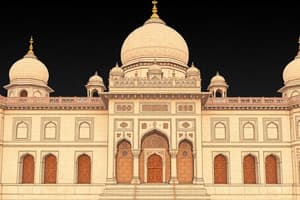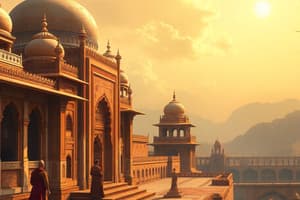Podcast
Questions and Answers
Who is best known for commissioning the Taj Mahal?
Who is best known for commissioning the Taj Mahal?
Which emperor's rule marked the peak of the Mughal period in terms of architectural achievements?
Which emperor's rule marked the peak of the Mughal period in terms of architectural achievements?
Who is known for efforts towards religious tolerance and syncretism, influencing the culture of the Mughal Empire?
Who is known for efforts towards religious tolerance and syncretism, influencing the culture of the Mughal Empire?
Which emperor was responsible for designing the Badshahi Mosque in Lahore?
Which emperor was responsible for designing the Badshahi Mosque in Lahore?
Signup and view all the answers
Under whose rule did Mughal architecture incorporate Persian influences and broader Indian architectural ideas?
Under whose rule did Mughal architecture incorporate Persian influences and broader Indian architectural ideas?
Signup and view all the answers
Which emperor faced challenges during his reign due to political turmoil and the decline of the empire's power?
Which emperor faced challenges during his reign due to political turmoil and the decline of the empire's power?
Signup and view all the answers
Who was the founder of the Mughal Empire?
Who was the founder of the Mughal Empire?
Signup and view all the answers
Which emperor of the Mughal Empire is known for defeating the Sultan of Delhi at the Battle of Panipat?
Which emperor of the Mughal Empire is known for defeating the Sultan of Delhi at the Battle of Panipat?
Signup and view all the answers
Under whose reign did Mughal architecture experience significant developments such as Agra Fort and Fatehpur Sikri Fort City?
Under whose reign did Mughal architecture experience significant developments such as Agra Fort and Fatehpur Sikri Fort City?
Signup and view all the answers
Which emperor of the Mughal Empire was succeeded by his son Akbar?
Which emperor of the Mughal Empire was succeeded by his son Akbar?
Signup and view all the answers
Who continued the legacy of his father by expanding the Mughal Empire further?
Who continued the legacy of his father by expanding the Mughal Empire further?
Signup and view all the answers
Study Notes
Empires of the Mughals: A Historical Overview
The Mughal Empire, which thrived from the mid-16th to the late 17th century, holds significant historical importance in India due to its lasting impact on both politics and culture. Founded initially by Babur, a descendant of Genghis Khan and Timur, the Mughals ruled over a vast territory, incorporating diverse populations and customs. Their reign saw the expansion of their kingdom from Agra and Delhi, encompassing nearly the whole of the subcontinent by the 17th century.
Emperors and their Reigns
Babur (1526–1530)
Babur, the founder of the Mughal Empire, established his rule after defeating the Sultan of Delhi, Ibrahim Lodi, at the Battle of Panipat in 1526. He was succeeded by his son, Humayun. Babur's reign saw the development of unique features that distinguished Mughal architecture from previous styles.
Humayun (1530–1556)
Humayun was succeeded by his son, Akbar, who became one of the most important and influential emperors of the Mughal Empire. During his rule, Mughal architecture flourished, with significant developments taking place under his patronage. Some notable structures built during this time include Agra Fort, Fatehpur Sikri Fort City, Buland Darwaza, Shalimar Gardens, and numerous other architectural marvels.
Akbar (1556–1605)
Akbar continued the legacy of his father, expanding the empire further and consolidating its power. He is also known for his efforts towards religious tolerance and syncretism, which influenced the culture of the Mughal Empire. Under his rule, the style of Mughal architecture reached new heights, incorporating Persian influences and assimilating broader Indian architectural ideas.
Shah Jahān (1628–1658)
Shah Jahān is best remembered for commissioning the magnificent Taj Mahal, which remains one of the most iconic landmarks in India even today. His reign marked the peak of the Mughal period in terms of architectural achievements, featuring the use of double domes, intricate ornamentation, and symmetrical designs. Additionally, he oversaw the construction of buildings such as Delhi's Red Fort, the Great Mosque at Fatehpur Sikri (Jami Masjid), and the palace-fortress at Delhi.
Aurangzeb (1658–1707)
As the last great Mughal emperor, Aurangzeb continued the traditions set by his predecessors but faced challenges during his reign due to political turmoil and the decline of the empire's power. Despite this, he was responsible for designing notable structures like the Badshahi Mosque in Lahore and Bibi Ka Maqbara. His rule marked the end of the golden age of Mughal architecture, which eventually gave way to successive regimes that would shape India's future.
Studying That Suits You
Use AI to generate personalized quizzes and flashcards to suit your learning preferences.
Description
Explore the history of the Mughal Empire, from Babur to Aurangzeb, and their significant architectural contributions in India. Learn about the reigns of key emperors like Akbar, Shah Jahān, and Aurangzeb, and their impact on Mughal architecture.




